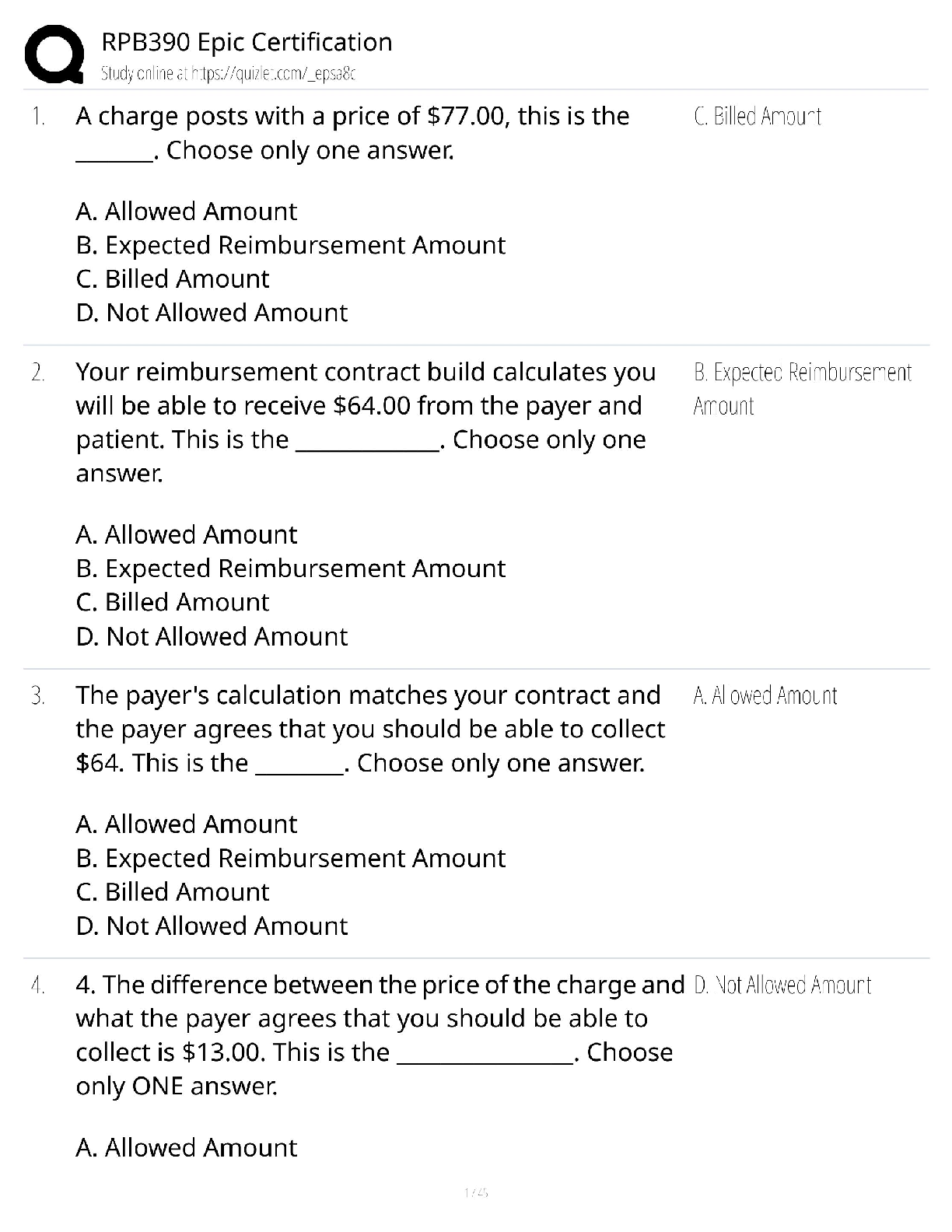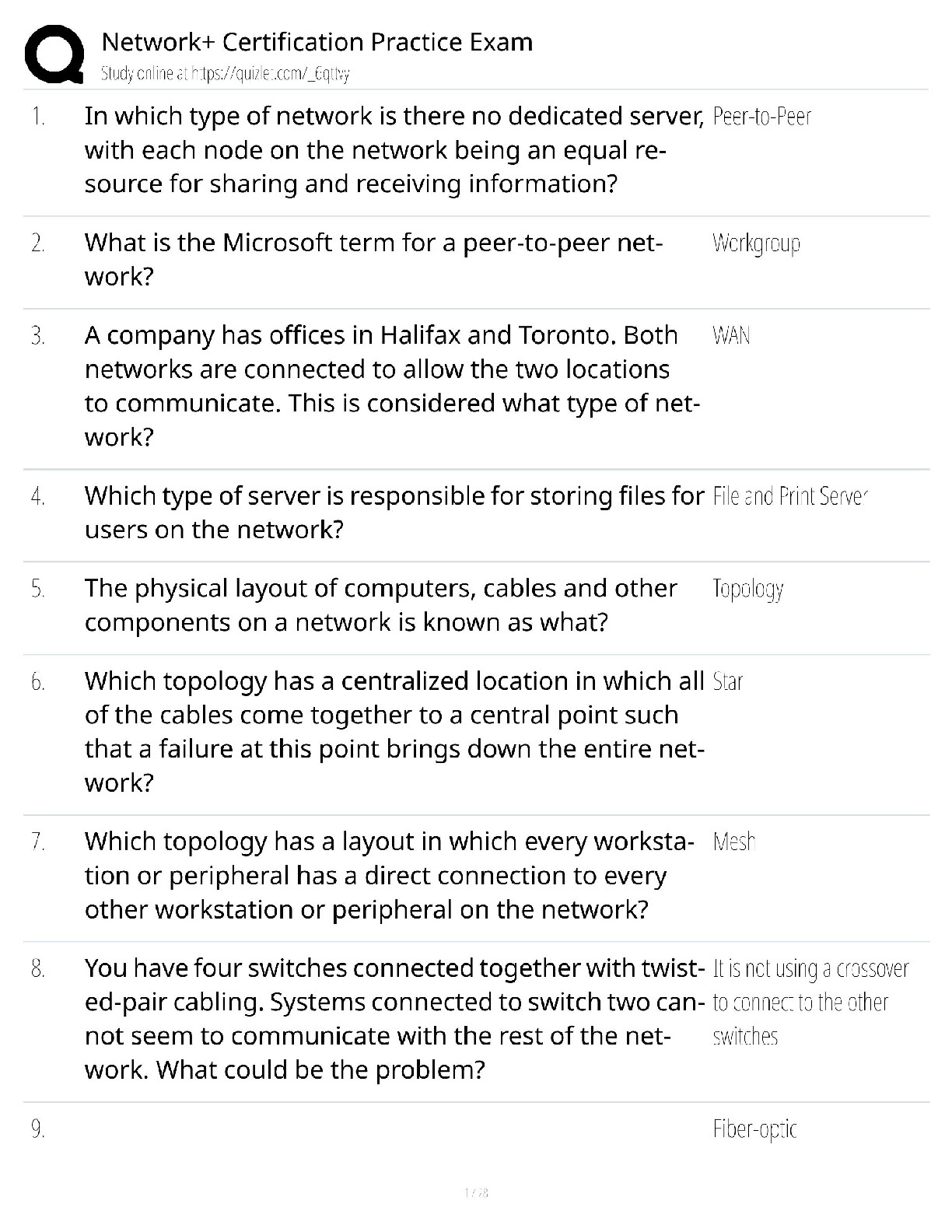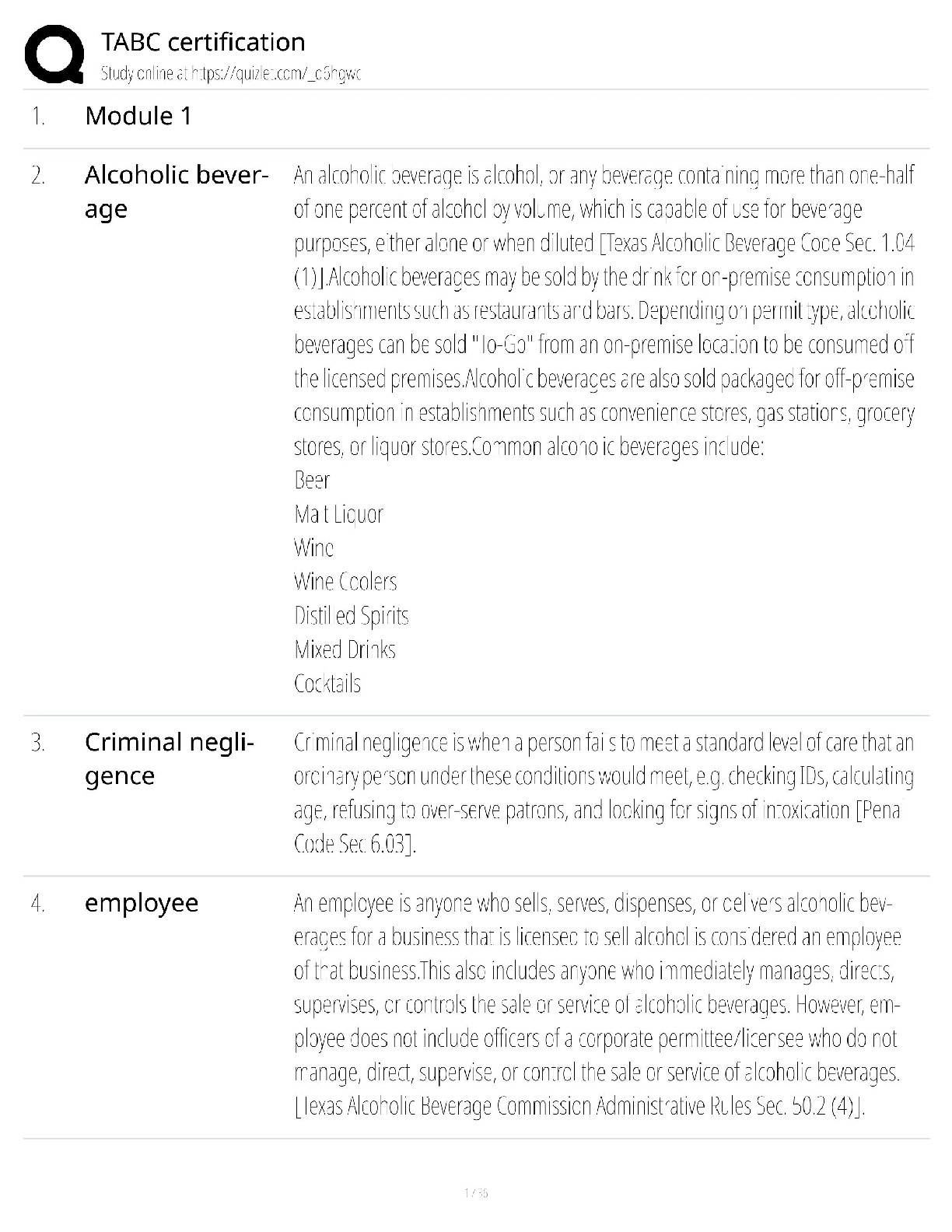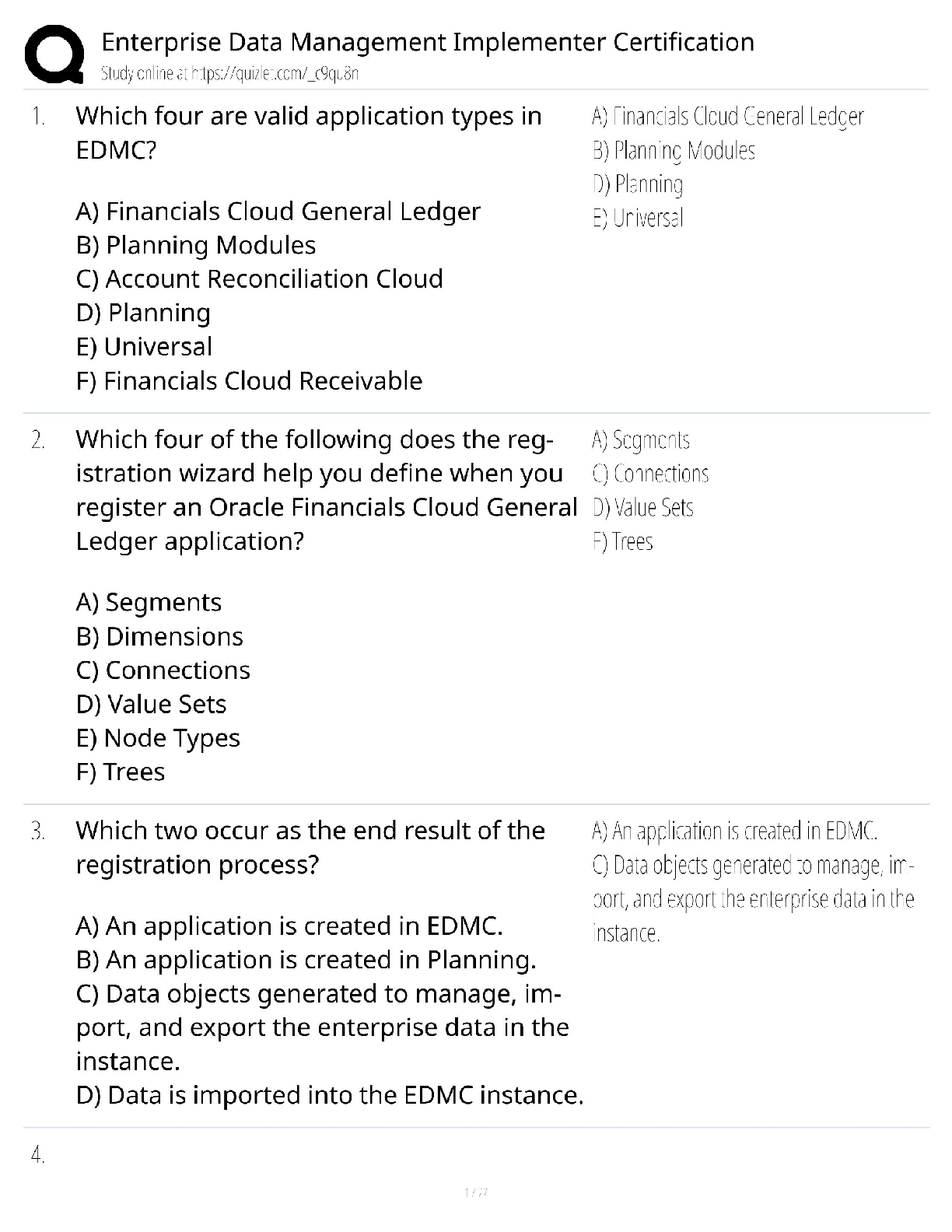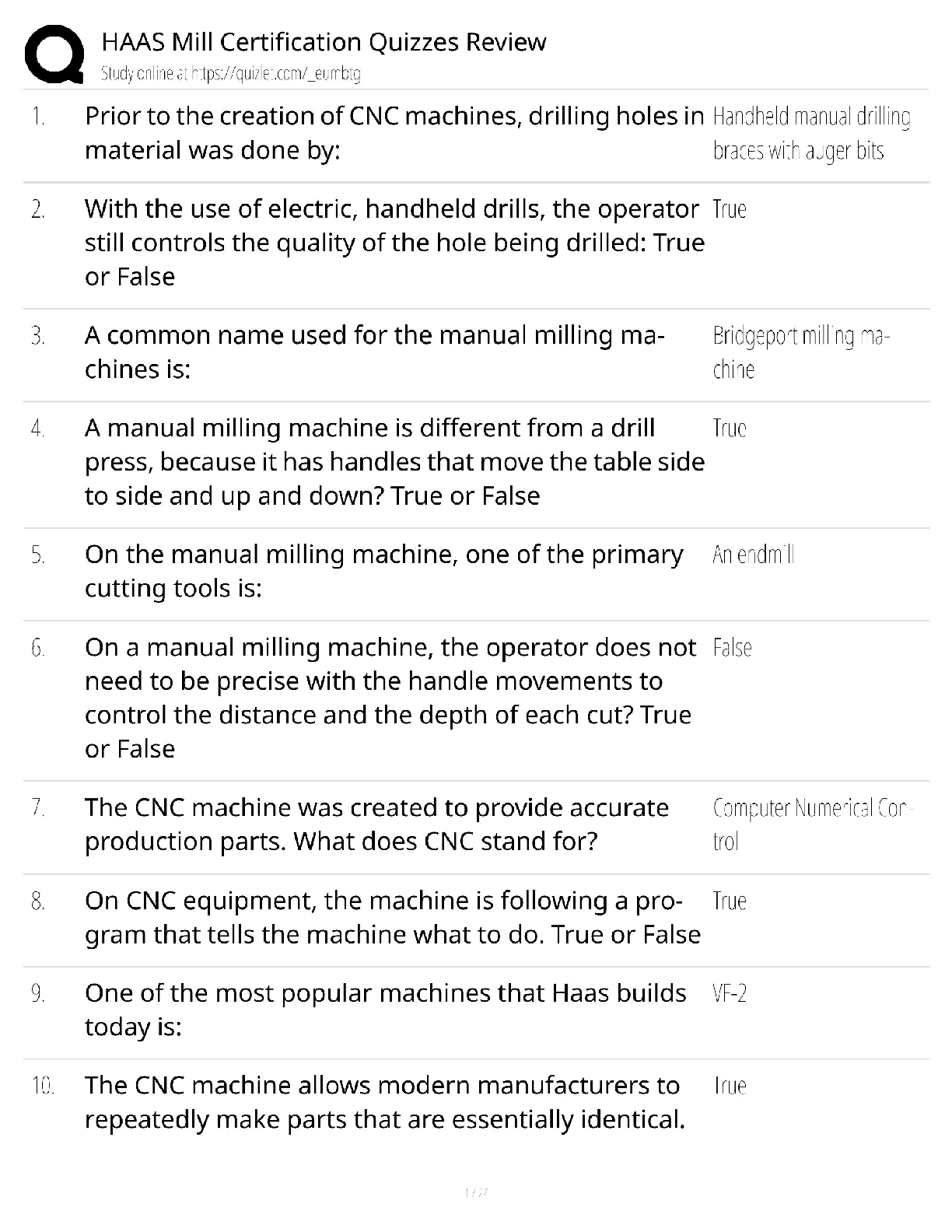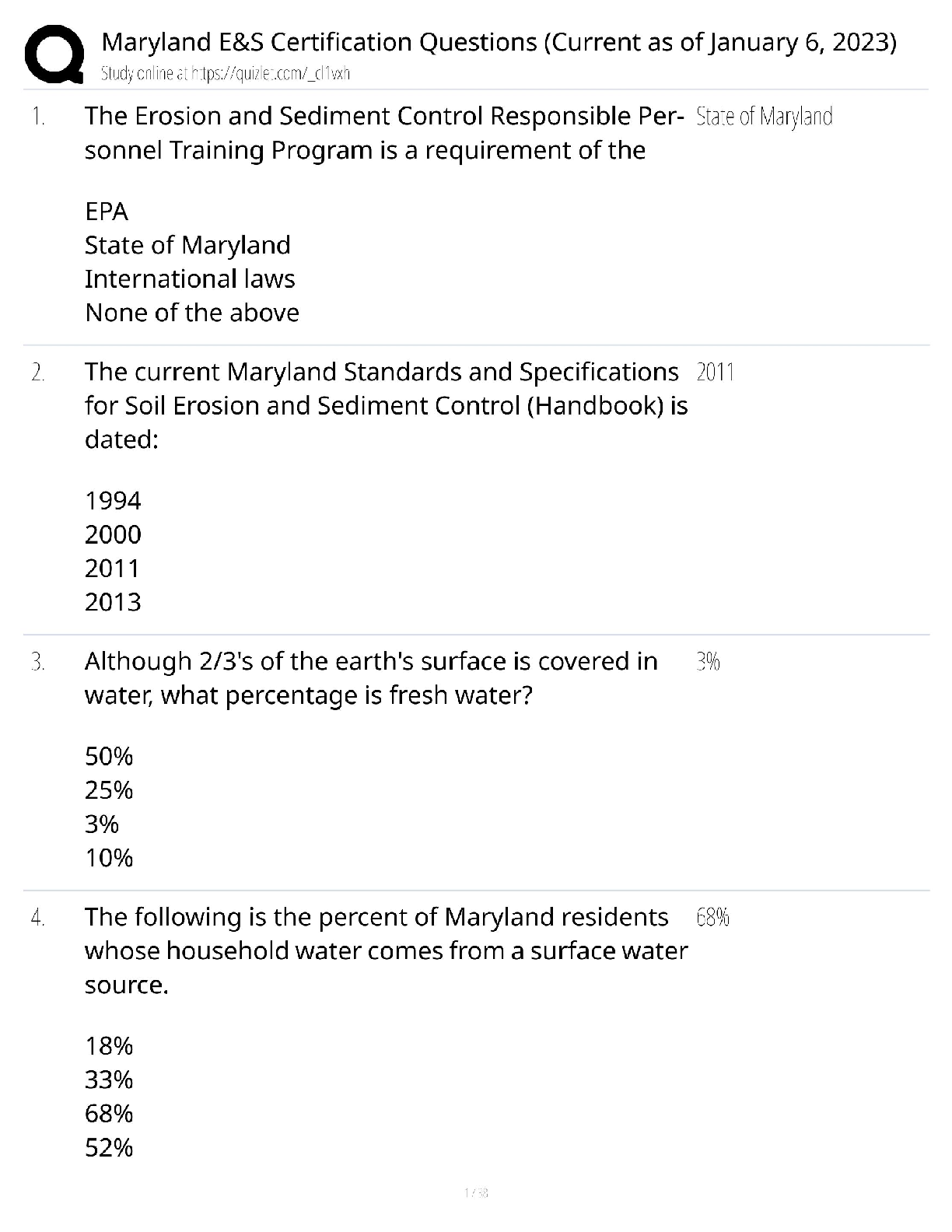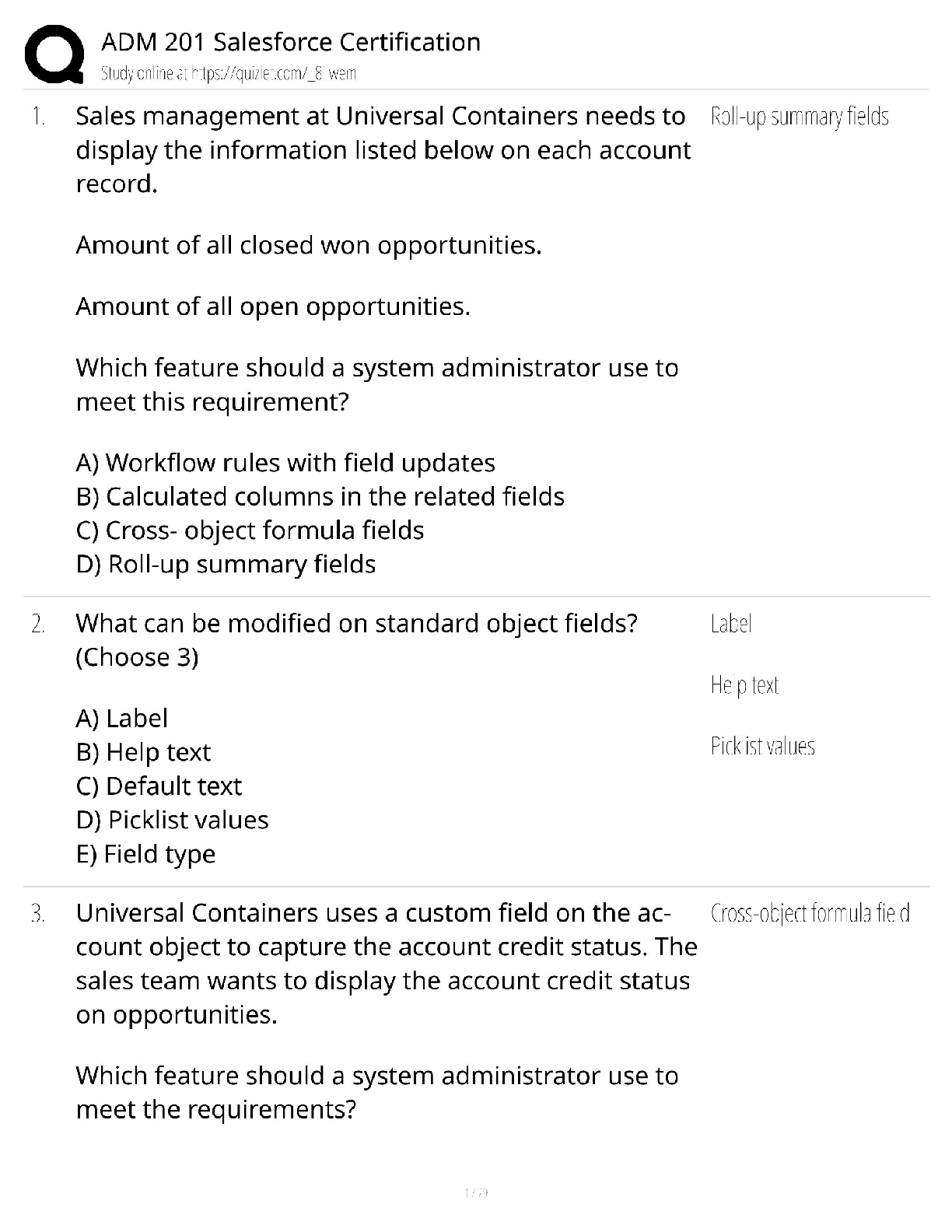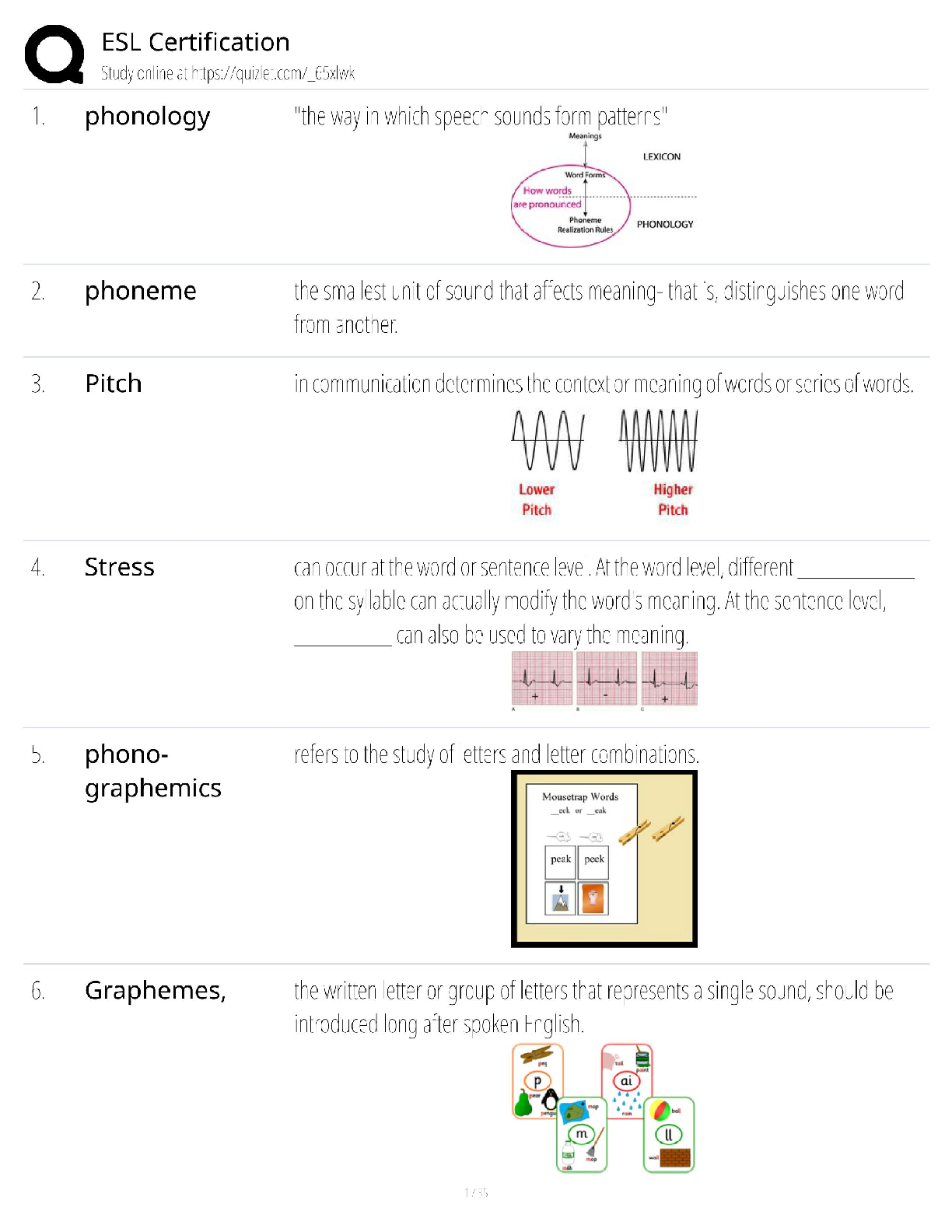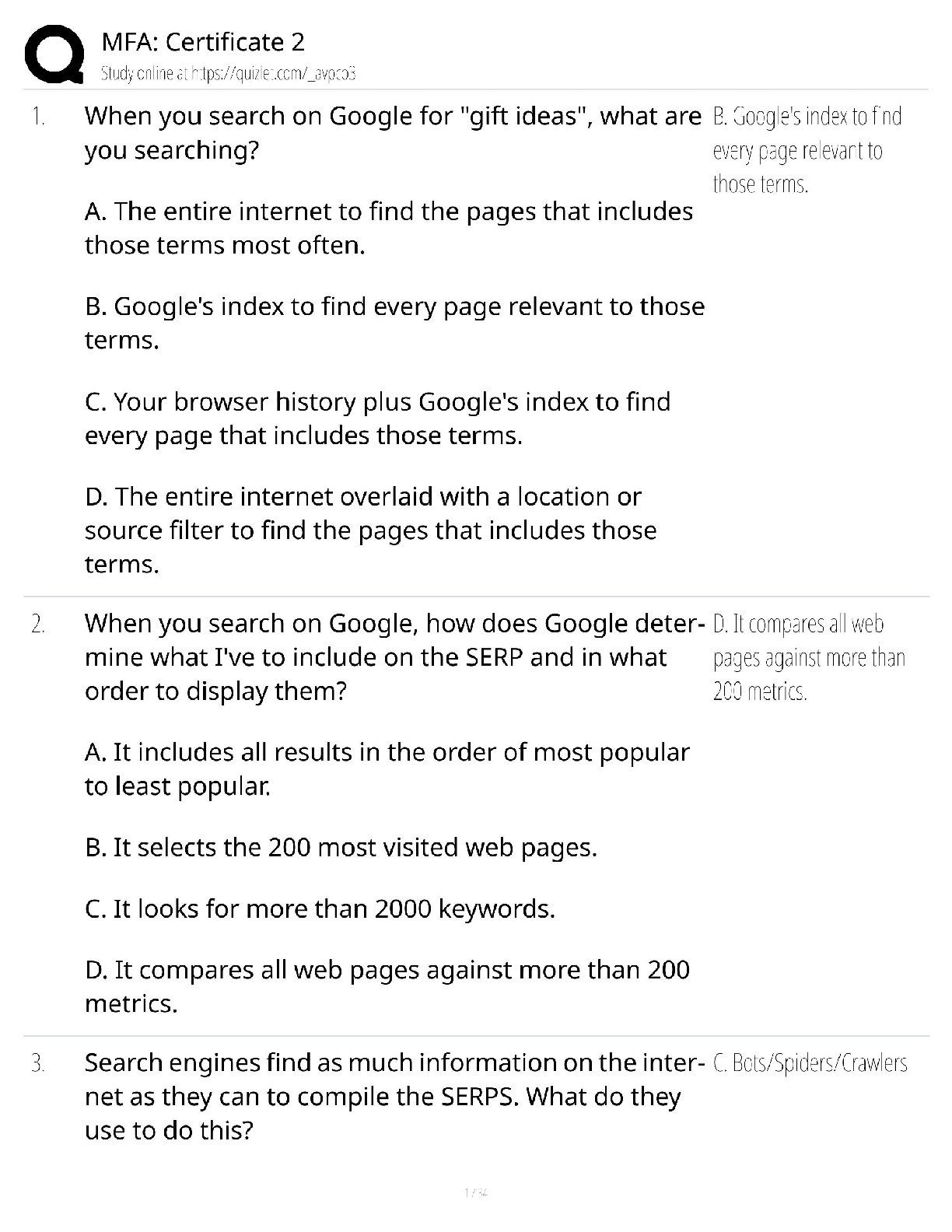Management > QUESTIONS & ANSWERS > D073 Best Practices in Management Questions and Answers Graded A (All)
D073 Best Practices in Management Questions and Answers Graded A
Document Content and Description Below
D073 Best Practices in Management Questions and Answers Graded A Autocratic leader ✔✔One with absolute power. Trait Theory ✔✔"Great Man Theory" Born as a leader Behavioral Theory ✔✔Eff ... ective leaders focus on influencing the performance and motivation of their employees. Job-Oriented Theory ✔✔Focus on helping employees improve their job performance. Situational Theroy ✔✔Leadership style is adapted to fit the situation of the employee. Emergent Theory ✔✔Leaders emerge naturally from within the group. Holocracy ✔✔Decision making is distributed throughout the team. Contingency Theory ✔✔Predicts that effective leaders are those whose personal traits match the needs of the situation Transactional Theory ✔✔Exchange between two parties. Leadership Style - Anti-change ✔✔Seeks to avoid change. "Stay the course. Keep adjusting small. No need to change in any major way." Leadership Style - Rational ✔✔Focuses on how to constrain and control change with the logical planning and clearly defined steps. Leadership Style - Panacea ✔✔Responds to pressure for change is to communicate and motivate. Have an understanding to the resistance of the change and has enthusiasm for change. Leadership Style - Bolt on ✔✔Regains control of change by attaching change management techniques that create a response to pressure for change. Leadership Style - Integrated ✔✔Use structure and discipline. Understands the culture, roles, capabilities, and attitudes of it's people. Leadership Style - Continuous ✔✔Creates and agile and quick responding organization that can quickly anticipate threats and seize opportunities. Strategic Management Process - 4 stages ✔✔Strategic Objectives, Strategic Formulation, Strategic Implementation, and Strategic Evaluation. Strategic Management Process - Strategic Objective ✔✔SWOT & PESTEL SWOT ✔✔Strength, Weakness, Opportunities, Threats PESTEL ✔✔Political Economic Social Technological Environmental Legal Strategic Management Process - Strategic Formulation ✔✔Goals and Objectives written on the information from SWOT and PESTEL Strategic Management Process - Strategic Implementation ✔✔Planning stops and action begins. Employees know their assignments, responsibilities, and authority. Strategic Management Process - Strategic Evaluation & Control ✔✔Performance measurements to determine progress and milestones. Corrective actions can be used if results are verified from the plan. Competitive Strategies - 3 Types ✔✔Cost Leadership, Differentiation, and Market Segmentation. Competitive Strategy - Cost Leadership ✔✔Ability to create Economies of Scale. Being able to produce a product in a large amount for an efficient price. Competitive Strategy - Differentation ✔✔To create a product or service that is unique and it satisfies a specific target market. Focused on branding. Competitive Strategy - Market Segmentation ✔✔Identifies a specific target group of customers that are not being satisfied by competition. The organization uses both differentiation and cost leadership. This approach describes a company that is focused only on economies of scale. Factors of Cultures - The Paradigm ✔✔Management determines both the mission and vision of the organization and sets the groundwork for the values that employees are expected to align with. Communication is critical. Factors of Cultures - Control Systems ✔✔Behavioral expectations are laid out explicitly for employees to read and understand. Factors of Cultures - Organizational Structures ✔✔Enormous cultural implications for openness of communication, organization of resources, and flow of information. Factors of culture - Power Structures ✔✔Being able (or not) to influence management. Factors of Culture - Rituals and Routines ✔✔Strong behavior Modifiers that significantly impact culture. Looser and open work environment, limited routine and high individual freedom. Factors of Culture - Stories and Myths ✔✔Stories are powerful communicators of culture. Big Five Traits - Openness ✔✔Broad range of interest . Curious about the world and other people. More adventurous and creative. Big five Traits - Conscientiousness ✔✔Goal directed behaviors, organized and mindful f teh details. Big Five Traits - Extraversion ✔✔Sociable, assertive, outgoing, and being around people energizes them. Big Five Trait - Agreeableness ✔✔Trust, kindness, and cooperative. Big Five Traits - Neuroticism ✔✔Sadness, Moodiness, Emotional instability. They experience mood swings, anxiety, and irritability. McClelland's Theory ✔✔Explains an Individuals motivation for learning. Motivated by power seeks out high levels of influence Herzberg's Two-Factor Theory ✔✔Job satisfaction is influenced by motivator factors, achievement, recognition, and responsibility. Hygiene factors, working conditions, coworkers relations, and policy and rules. Equity Theory ✔✔How is the employee treated in relations to other employees. Vroom Theory ✔✔Employee must value the results and expect their behaviors will result in the achievement of a reward. simple conflict ✔✔conflict over differences in ideas, definitions, perceptions, or goals. pseudo conflict ✔✔the perception that conflict exists when it doesn't ego conflict ✔✔conflict based on personal issues in which people attack each other's selfesteem, personal attacks and character assassinations. Conflict Resolution Strategies - Integrative Approach ✔✔Focus on the issue to be solved and aim to find resolution that meets everyones needs. Conflict Resolution Strategies - Distributive Approach ✔✔Divide a fixed number pf positive outcomes/resources in which one side comes out ahead of another who doesn't get their way today but may end up winning tomorrow. Conflict Resolution Strategies - Mediating Approach ✔✔Bring in a third party to facilitate a non confrontational discussion to help the team reach a consensus about how to resolve the conflict. Smoothing ✔✔Attempts to minimize the difference among the people who conflict with each other. Yielding ✔✔Describes the choice team members make to give in when others disagree with them rather than engage in conflict. Stake is small Avoiding ✔✔Team member may choose to ignore all but most contentious disagreements. 8 Components of the Communication Process- Source ✔✔Person that imagines, creates and sends the message. 8 Components of the Communication Process- Message ✔✔The Stimulus or meaning produced by the source for the receiver or audience. 8 Components of the Communication Process- Channel ✔✔How a message travels between the source an the reciever. 8 Components of the Communication Process- Reciever ✔✔Receives the message from the source 8 Components of the Communication Process- Feedback ✔✔When you respond to the source. 8 Components of the Communication Process-Enviroment ✔✔The atmosphere you send and receive the message. 8 Components of the Communication Process- context ✔✔Involves the setting, scene, and expectations of the individuals involved. 8 Components of the Communication Process- Interference ✔✔Anything that blocks or changes the sources's intended meaning of the message. Three Models of Communication - Transmission ✔✔Communication is Linear. one way process in which a sender intentionally transmits a message to a receiver. Three Model Communication - Interactional ✔✔Communication is a process in which participants alternate positions. Instead of one way process this model incorporates feedback. Three Model of Communication - Transaction ✔✔You communicate to create relationships. Competitive Listening ✔✔happens when we are more interested in explaining our own point of view than in understanding someone else's Appreciative Listening ✔✔listening for pleasure or enjoyment Active Listening ✔✔empathetic listening in which the listener echoes, restates, and clarifies. Passive Listening ✔✔listening role in which the listener does not share in the responsibility nor involve himself in the communication process Combative Listening ✔✔When a person listens very intently to senders messages for the purpose of attacking them, often by using their own words against them as soon as they are finished speaking. Kolb Learning Cycle- Step One ✔✔Experience - The thing that happened Kolb Learning Cycle - Step Two ✔✔Publishing - Participants reflect on themselves Kolb Learning Cycle - Step Three ✔✔Processing - Participants reflect on observations of others who shared the experience. Kolb Learning Cycle - Step Four ✔✔Generalizing - Participants work to relate the experience to other aspects of their life. Kolb Learning Cycle - Step Five ✔✔Applying - Participants consider how they can apply the results of the experience in the future. SMART Goals ✔✔Specific Measurable Attainable Realistic Time-bound Smart - Specific ✔✔Focused, defined, Clear. Objective should identify the expected actions and outcomes. 5 w' What do I want to accomplish? Why is this goal important? Who is involved? Where is it located? Which resources or limits are involved? sMart - Measurable ✔✔Keeps you focused and Motivated. 3 H'sHow much? How many? How will I know when it's accomplished? smArt - Achievable ✔✔Crucial for all Stakeholders. Must be attainable. smaRt - Relevant ✔✔Your goal aligns with the company's mission smarT - Time bound ✔✔Having a schedule or deadline. They will help increase productivity and prevent work from dragging on. salient ✔✔Information relates to a particular context that makes it meaningful and relvant. Mission ✔✔What a Company does well Vision ✔✔What a company would like to do well Values ✔✔What a company thinks is important Long Range Planning ✔✔Helps companies determine where they want to be. "Big Picture" Controlling ✔✔Evaluation and correcting action and Processes Environmental Scanning ✔✔Involves observing external practices of competitors. Worrying what the competition is doing Supervision ✔✔To over see Coordinating ✔✔"Orientating" Working together Customer Relations & Marketing ✔✔Satisfaction in highlighting new goods and service Community Relations ✔✔This required interpersonal skills because you're building relationships within the community Internal Consultant ✔✔You're working within the Organization Monitoring Products & Services ✔✔Making sure you monitor and make sure what you've implemented is going as planned. Operational Strategies ✔✔The Methods companies use in order to reach their objectives Customer-Driven Strategies ✔✔Focus on meeting the needs of the customer Product Management ✔✔developing, maintaining, and improving a product Supply Chain Management ✔✔The process of transporting goods from one location to another Inventory Management - Cycle count ✔✔Automatic/Systematic count of Inventory Inventory Management - Physical Count ✔✔Manually count of Inventory. You touch all items. Forecasting ✔✔Also knowing as "Assuming" Scheduling ✔✔Prescribing of when and where each operation necessary to manufacture your products and goods Quality Assurance ✔✔Same as "Quality Management". Making sure the quality of the goods and services you're producing are quality. Facilities, Planning and Management ✔✔Overseeing the entire process and making sure goods and services are available. Master Budget ✔✔Has to parts Operating and Financial Production Budget ✔✔Consists of cost inside the organization Vairable costs ✔✔Costs that are directly related to the level of output produced Fixed Expenses ✔✔Costs that do not change from month to month Direct labor ✔✔Cost for all employees Manufacturing Overhead ✔✔Manufacturing costs that are indirectly associated with the manufacture of the finished product. ie electric needed for equipment Selling and Administrative Expense Budget ✔✔A projection of anticipated selling and administrative expenses for the budget period. Cash Budget ✔✔Used to pay for any Purchases. Variable and fixed cost. Project Management Phase 1 ✔✔Define Projects - What are you planning to do Project Management Phase 2 ✔✔List all of the tasks- You initial to do list Project Management Phase 3 ✔✔Estimate Resources Needed- Who is going to help Project Management Phase 4 ✔✔Consider Constraints on time, money, and resources- Do I have enough time and money? Did I ask the right people to help? Project Management Phase 5 ✔✔Develop detailed Implementation plans- Your actual structured outlines Unfreezing ✔✔getting the people affected by change to believe that change is needed Refreezing ✔✔strengthening the new behaviors that support the change. The Change becomes the new standard Structural Change ✔✔Dramatic shift in the way a business operates. Change Management ✔✔Recognize the changes develop the necessary adjustments for the needs. Train the employee on the change and win the support of the employee Key Enablers to Change ✔✔Transparency and effective communication, Effective education and training, Personal counseling, monitoring the implementation Staffing ✔✔Activities for their hiring of full time and part time employees. This includes contractors, terminating employees and their contracts. Training and Professional Development ✔✔Onboarding employees and training. Developing the activities needed for training and preparing new employees Compensation ✔✔The salary and benefits. The scope of resource management Safety and Health ✔✔The understanding and implementation of safety including working with OSHA Employee and Labor Relations ✔✔Working with equal employment opportunity, discussing employee rights, Unions. Human Capital ✔✔Defined by knowledge, skills, abilities, and the capability to develop, innovate, and process by people within the organization. McClelland's Need Theory ✔✔The need for achievement as a driver for motivation. The motivates for learning include achievement, power, or affiliated. People with a high Achievement -McClelland's Need Theory ✔✔They prefer a task with a moderate level of difficulty, feels a personal responsibility for performance. Individuals Who Have a High Need for Affiliation - McClelland's Need Theory ✔✔They want to influence others and control their environment. Herzberg's Two Factor Theory - Job Dissatisfaction ✔✔Influenced by Hygiene Factors such as working conditions, policies and rules, base wage, and salary Herzberg's Two Factor Theory - Job Satisfaction ✔✔Influenced by Motivator Factors such as Achievement Recognition, Responsibility, Work itself, advancement, and personal growth Conflict ✔✔A state of discord caused by the actual or perceived opposition of needs, values, or interest between people working together Substantive Conflict ✔✔Issue-focused - involves disagreements over goals, resources, rewards, policies, procedures, and job assignments Affective Conflict ✔✔People Focused - Based on personality conflicts, differing communication styles, perceptions of a coworkers contributions Interpersonal Conflict ✔✔Two individuals have different goals. Intrapersonal Conflict ✔✔conflict that occurs within an individual Intergroup Conflict ✔✔Two teams within the same organization Intragroup conflict ✔✔Two individuals within the same group Personal Conflict ✔✔Can included personal differences, differences based on values, diversity of attitudes. Informational Deficiencies ✔✔Occur when team members do not share relevant information Role Incompatibility ✔✔Conflicts evolve from the perception that assigned goals and responsibilities compete with those of others. Complex reporting structures. Scarcity of Resource ✔✔Occurs when two people rely on a third person to meet identical deadlines Irrational Stubbornness Biases ✔✔Stick to the plan Zero-sum Thinking Biases ✔✔If you win- I lose Anchoring Bais ✔✔Original Price $3,000, today $2,000 Framing Biases ✔✔The same option is presented in two ways. One option seems more appealing than the other. First Impression Biases ✔✔More weight is given to the first data presented Shared Negotiation Biases ✔✔Two parties in the negotiation Overconfidence Biases ✔✔I won once - I will win again Identifying Short-term Goals ✔✔What is the function of a tactical plan? transforms Resources into Profits ✔✔What is the function of operations management in achieving strategic goals? Current Profit ✔✔Which information does a projected income statement report as a function of the budget-planning Process? Income Statement ✔✔Which report shows the change in the company's financial performance over a stated period of time? Sales Plan ✔✔Which component must be developed when creating an operating budget for the upcoming fiscal year? For control purposes ✔✔Why should a manager regularly compare budgeted revenues and expenses with actual operational performance? Create a Contingency Fund ✔✔The operations manger for a chain of restaurants is budgeting for the addition of more healthy menu options and realizes the project may involve unanticipated cost. How should the manger budget for these costs? Agility ✔✔Which organizational characteristic affects a company's ability to rapidly change its processes? Reduce Process Inefficiencies ✔✔What is the purpose of using Lean techniques in change management? Demonstrating The Urgency For Change ✔✔What is a purpose of the first step in Lewin's change model? Refreezing ✔✔A company's new way of doing things is becoming ingrained in the routine of how the company operates on a day to day basis. Which stage of Lewin's change model is presented in this company? Role Modeling ✔✔Which term describes employees' efforts to emulate the behavior of leaders seeking to affect change within organizations? Create new symbols and stories ✔✔How should a company influence organizational culute to support a change management initiative? Openness ✔✔Which element of the big five model positively influences a person's desire to embrace change within and organization? Listening to what the naysayers have to say ✔✔Which action is recommended for leading change effectively within an organization? Fulfills the plan ✔✔Why should companies conduct human capital planning as part of the strategic planning process? They can obtain performance feedback from a variety of stakeholders ✔✔How can people benefit from 360 degree reviews as part of their professional development efforts? Reduce production costs by eliminating waste ✔✔When employees receive training on making dental equipment, they are taught the quality standards for each product they will be involved in manufacturing. What is a purpose of this training? Organizational change can take many forms. ✔✔It may involve a change in a company's structure, strategy, policies procedures, technology or culture. Managers often find themselves at the forefront of busness process change management and need to manage it effectively. ✔✔They do so by (P-O-L-C) Plan, organize, lead and control. Conner's Leadership Styles ✔✔He identified six distinct leadership styles. The anti-change leader. The rational leader. The panacea leader. The bolt-on leader. The integrated leader. Anti-change leader ✔✔A leader embracing this style seeks to avoid change as much as possible. The message is "Stay the course." Rational leader ✔✔This leader focuses on how to constrain and control change with logical planning and clearly defined steps. The panacea leader ✔✔This leader believes that the way to respond to pressure for change is to communicate and motivate. These leaders understand the resistance to change they are likely to encounter as well as the inevitability of change as organizations evolve. They tend to focus on fostering enthusiasm for change. The bolt-on leader ✔✔This leader strives to regain control of a changing situation by attaching (bolting on) change management techniques to ad hoc projects that are created in response to pressure for change. This manager is more concerned about helping others change than creating a strategy for the actual change itself. integrated leader ✔✔This leader searches for ways to use the structure and discipline of what Harding and Rouse (2007) called "human due diligence" (the leadership practice of understanding the culture of an organization and the roles, capabilities, and attitudes of its people) as individual change projects are created and implemented. The concept is to combine or integrate human and cultural concerns with the strategy itself. The continuous leader ✔✔This leader works to create an agile and quick-responding organization that can quickly anticipate threats and seize opportunities as change initiatives are designed and implemented. Continuous leaders believe that disruption is continuous and adaptability a necessary organizational competency. Scope Change ✔✔Any change to the project scope. A scope change almost always requires an adjustment to the project cost or schedule. incremental change ✔✔A process in which small improvements or changes are made to processes and approaches on an ongoing basis adhoc ✔✔done for a specific purpose, without regard for larger or future issues paradigm ✔✔a model; an example artifact ✔✔an object made by a human being, typically an item of cultural or historical interest. postulates/axioms ✔✔Statements that are accepted without proof top-down change ✔✔change implemented by managers at a high level in the organization mechanistic organization ✔✔authority is centralized, tasks and rules are clearly specified, and employees are closely supervised bottom-up approach ✔✔encouraging the flow of ideas from lower levels and making sure they get heard and acted upon by top executives Department Silos (barrier-hurdle to change) ✔✔They focus on local optimization at teh expense of the entire system. Barriers (also called hurdles and obstacles to change) ✔✔Issues with implementation methods, poor communication, or ineffective leadership. Also a lack of technology skills, inadequate training and fear of lowing power or even their job increase. rituals and routines ✔✔Routines are strong behaviors modifiers that signicantly affect the culture of a given organization. [Show More]
Last updated: 2 years ago
Preview 1 out of 29 pages
.png)
Buy this document to get the full access instantly
Instant Download Access after purchase
Buy NowInstant download
We Accept:

Also available in bundle (1)
Click Below to Access Bundle(s)
.png)
WGU D073 BUNDLED EXAMS QUESTIONS AND ANSWERS WITH COMPLETE SOLUTIONS
WGU D073 BUNDLED EXAMS QUESTIONS AND ANSWERS WITH COMPLETE SOLUTIONS
By Nutmegs 2 years ago
$16
9
Reviews( 0 )
$10.00
Can't find what you want? Try our AI powered Search
Document information
Connected school, study & course
About the document
Uploaded On
Jan 14, 2023
Number of pages
29
Written in
All
Additional information
This document has been written for:
Uploaded
Jan 14, 2023
Downloads
0
Views
139





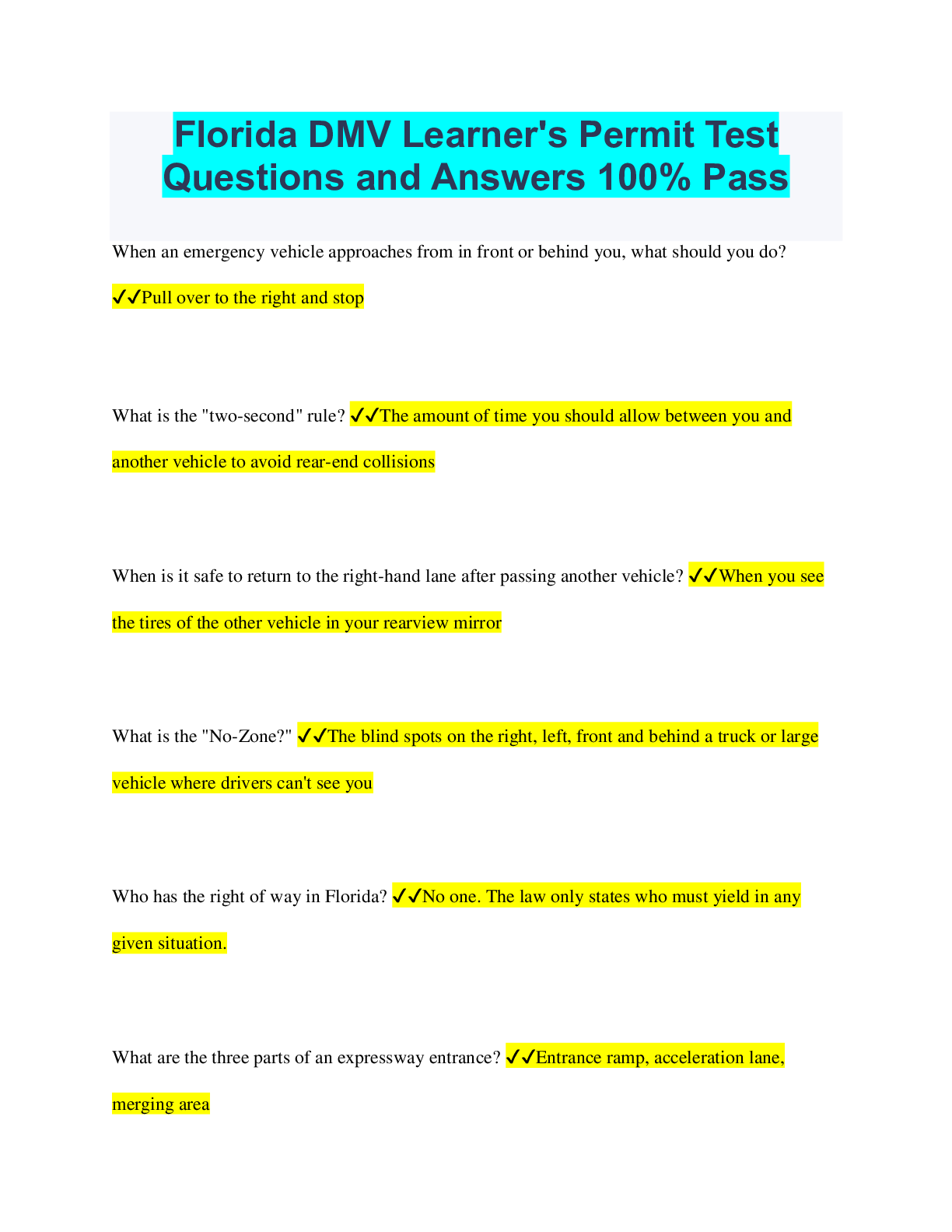
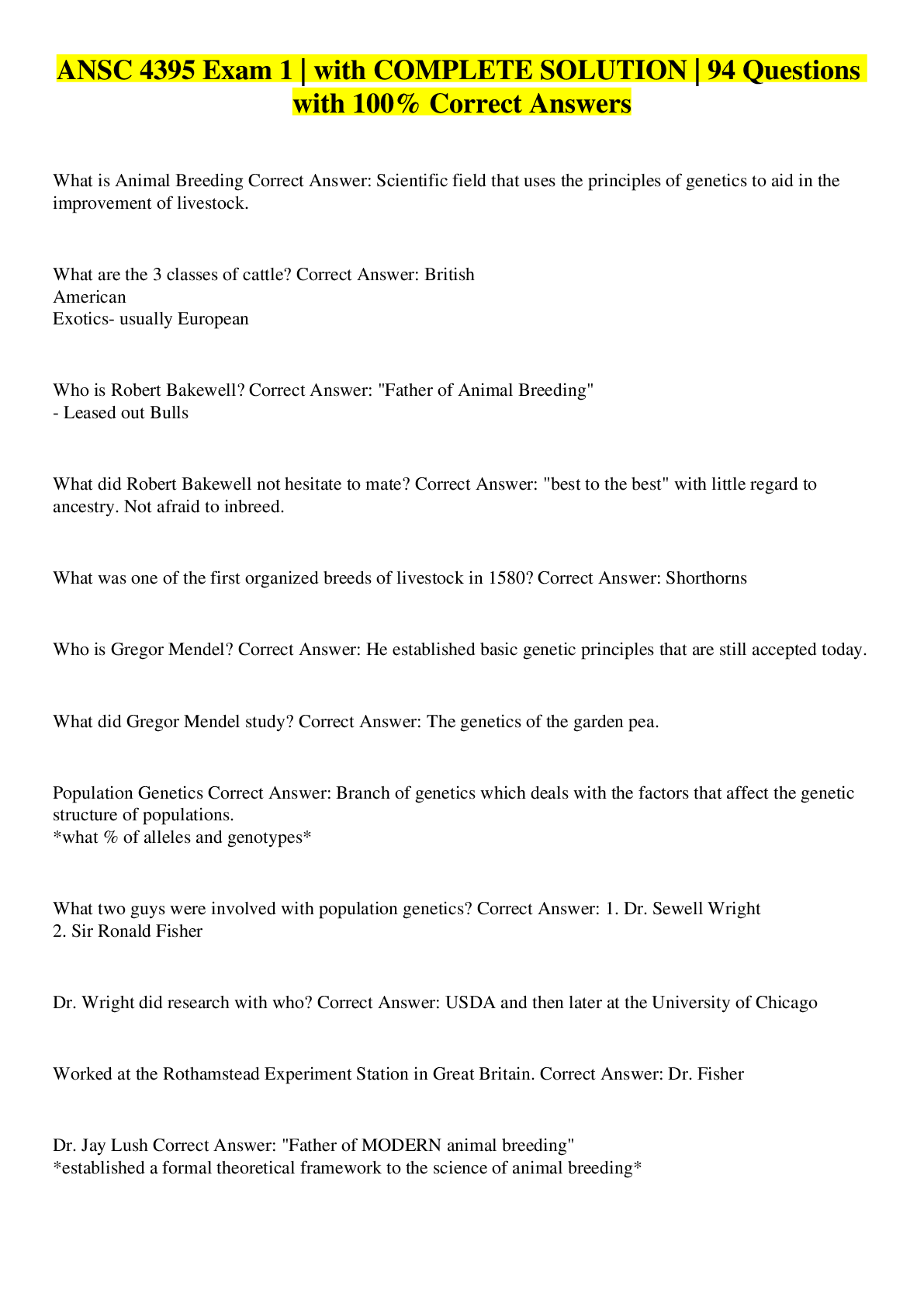

.png)





